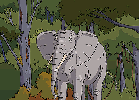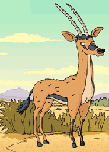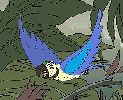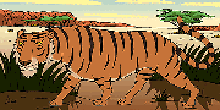|

Main

Meet the Characters

Thornberrys' Wild Animals
|
 Albatross
Albatross
The albatross only lands to breed and an immature bird might circle the
world several times before it touches the ground. The black-browed
albatross can excrete a smelly oil to fight off predators that it also
uses to preen itself with. The albatross can drink sea water and excrete
the excess salt from their nasal passages. The wandering albatross has a
wingspan of 9 feet, the largest of any living bird. The word albatross
comes from the Portugese word alcatraz, which means "any large
bird". Some albatross may live up to 80 years.
 African Elephant
African Elephant
The African elephant is the largest and most powerful of all living land
mammals. Each one eats up to 500 pounds of vegetation a day and can drink
up to 40 gallons of water at a time. Elephants not only have close family
ties, but have "death rituals" as well. When an elephant in the
herd die, the others cover the corpse with tigs and leaves and stay by the
"grave" for many hours. Elephants love to bathe and most herds
never stray too far from a source of water. During dry seasons, elephants
have been known to dig in the sand of dried over river beds to get to
water buried underneath. A great swimmer, elephants sometimes use their
trunks as snorkels. Asian elephants are slightly smaller than Africans and
have been used domestically by man for the last 5500 years. Elephants can
emit a low-frequency call that is too low for humans to hear, but can be
heard by other elephants over 12 miles away.
 Flying Squirrel
Flying Squirrel
The Southeast Asia species of flying squirrel can glide 350 feet. The main
enemy of the flying squirrel are hawks and owls, who prey on them up in
the trees. But flying squirrels avoid all other ground predators. During
the winter, groups of 20 or more flying squirrels often gather to sleep
together for warmth. Like some species of bats, flying squirrels have a
thin membrane which is attached to its wrists and to its legs. This
membrane helps the animal glide from tree to tree.
 Gazelle
Gazelle
The Thompson's gazelle can run consistently at speeds of over 35 miles an
hour for about 15 minutes and has been known to reach up to 50 miles an
hour when running from predators. Male gazelle horns are thick, ringed and
lyre shaped. Females are thinner, ringless and straight. When a gazelle
leaps vertically into the air, it is called "pronking". The
Thompson's gazelle has black stripes on its face and on its body that
helps break up the animal's outline and makes it harder to see from a
distance. Although they are easily frightened, gazelles have been known to
graze peacefully in plain sight of a pride of lions.
 Hippos
Hippos
Hippos spend up to 18 hours a day in the water to keep themselves cool and
support their huge bodies, which are second in weight only to those of the
elephant. Hippos have their own natural sun screen. Their skin secretes a
pink mucous that protects it from burning and maintain moisture on dry
land. A hippo can stay underwater for up to five minutes, and many animals
have been known to bask on its back, including turtles, birds and even
crocodiles! For an animal of its size, hippos eat relatively small amounts
of food (around 90 pounds a night). This is because most of the day they
are submerged in water, exerting little energy. Hippos have extremely
large teeth around 20 inches long in their lower jaw that can inflict
lethal wounds. The pygmy hippopotamus, a smaller relative to the common
hippo, can be heard eating over 150 feet away.
 Owl
Owl
A new species of owl is recorded about once every 10 years and many more
are believed to exist. Some superstitions believe the owl to be a
foreshadowing of death or misfortune. The short-eared owl can turn its
head 180 degrees and has incredibly keen hearing. Their eyes are capable
of 340 degree monocular (single eye) vision, but only limited binocular
(both eye) vision. Although most owls are noctournal hunters, the snowy
owl will often hunt in broad daylight. The eagle owl, one of the largest
owls, preys on other predatory birds like hawks, and was once seen
carrying a full-grown fox in its talons. When introduced in Malaysia to
control rat populations, each barn owl family killed 1300 rats a year.
Owls do more than just hoot. Tawny owls produce bubbling trills, loud
moans and hissing noises, while barn owls are known to make a hoarse
"khurrew" sound.
 Parrots
Parrots
Parrots have two claws facing forward and two facing backward that enables
them to grasp tightly onto trees and climb branches. They have long tails
that enable them to balance more efficiently.Male and female eclectus
parrots have such a noticeable difference in the color of their plumage
that at one time they were thought to be different species. One of the
most beautiful parrots, the princess parrot, is a protected species and is
in danger of extinction. They are rarely seen by humans. Macaws have
strong attachments to their mates. Many stay together for their entire
lives. Macaws have powerful beaks that enable them to crack open nuts
other birds cannot, giving them an advantage in viable food sources over
other birds. There are over 300 members of the parrot family, but only a
third are called parrots. The others are called macaws, parakeets,
cockatoos and lorikeets.
 Penguin
Penguin
The emperor penguin can dive to a depth of 870 feet and stay underwater 18
minutes. During breeding season, males may not feed from March until
July...over 100 days without food. Emperor penguins have adapted their
plumage to survive in the harsh artic conditions in which it lives. It has
two dozen feathers per square inch on its body. A penguin breeding
colonies are calledrookeries. Penguins are found outside of cold
Antartic waters. They actually inhabit waters of widely varying
temperatures and are found as far north as the Galapagos islands. Most
penguins are more adapted to swimming than walking, and hobble clumsily on
land. An exception to this is the macaroni penguin, which can hop with
both feet fairly gracefully.
 Polar Bear
Polar Bear
The polar bear, one of the largest land carnivores in the world, is well
suited for its icy home. Its fur is white or light yellow, allowing it to
blend in with its environment, and its feet are covered in fur, allowing
it greater stability on the icy ground. Polar bears can smell whale
carrion up to 20 miles away. Their keen sense of smell is crucial in their
success as hunters. The one thing that can give away the presence of a
polar bear is its black nose, which can be seen thru binoculars up to 6
miles away. No bigger than rats when they are born, polar bears grow up to
11 feet tall when standing. Polar bears are excellent swimmers, able to
stay underwater for 2 minutes. They can swim at a constant rate of about 6
miles per hour. A Polar bears diet consists mostly of seals, but at
various times of the year also includes whale and wlarus carcasses,
lemmings, foxes and even vegetation.
 Sharks
Sharks
A sharks sense of smell is so important that two thirds of its brain is
devoted to processing scent information. Helicopter engine noise can
attract sharks. They send out the right frequencies for them to hear.
Sharks can be cannibalistic, and often eat their young. The largest shark
is the 65 foot 70 ton whale shark, which feeds only on plankton. The tiger
shark, not the great white, has been responsible for more fatal attacks on
man than any other species of shark. Sharks have electro receptors in the
front of their bodies that help them capture their prey by monitoring
their muscle movements. As shark teeth are broken or lost, new ones grow
in to take their place. Sharks come in all shapes and sizes. The pygmy
shark rarely reaches more than eight inches in length.
 Tiger
Tiger
Siberian tigers are capable of dragging prey so heavy that it
would take a dozen or more men to move. Weighing anywhere from 400 to a
whopping 850 lbs., the Siberian tiger is the largest living cat in the
world. It is able to eat over 100 lbs. of meat in a single sitting. The
roar of a Bengal tiger can be heard up to a mile away. Tigers always eat
their prey from the hindquarters first. A Bengal tigers front teeth are
crucial to its survival. If they get damaged or lost, the tiger will
starve to death. Siberian tigers are able to retract their claws while
walking and unsheath them while hunting prey or fighting. Siberian tigers
have adapted to their colder environment than their relatives the Bengal
tigers by growing a thicker coat of hair and an extra layer of fat to keep
it better insulated.
|
 Albatross
Albatross










 African Elephant
African Elephant Flying Squirrel
Flying Squirrel Gazelle
Gazelle Hippos
Hippos Owl
Owl Parrots
Parrots Penguin
Penguin Polar Bear
Polar Bear Sharks
Sharks Tiger
Tiger